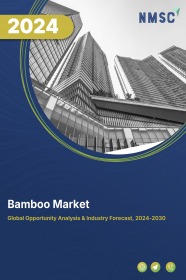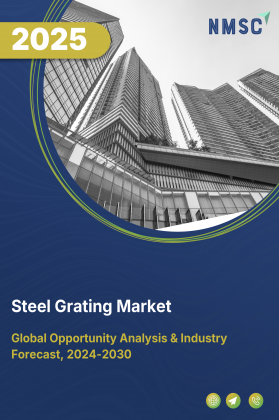
Bamboo Market by Bamboo Type (Tropical Bamboo, Herbaceous Bamboo, Temperate Bamboo), by Species (Moso Bamboo, Bambusa Vulgaris, and Others), by Product Type (Raw Culms & Basic Materials, Structural Timber & Poles, Engineered Boards & Panels, Processed Fiber & Yarn, Textiles & Apparel, Pulp & Paper Products, Food & Edible Shoots, Charcoal & Biofuel, and Others), and by End-Use Industry (Construction & Infrastructure, and Others) – Global Opportunity Analysis and Industry Forecast, 2023–2030
Market Definition
The global Bamboo Market size was valued at USD 49.58 billion in 2022, and is predicted to reach USD 71.29 billion by 2030, with a CAGR of 4.7% from 2023 to 2030. The bamboo market revolves around the adaptability and eco-friendly nature of bamboo plants. These bamboos are known for their rapid growth and are used in various applications, including construction materials, paper, textiles, kitchenware, and others.
Bamboo is considered as an eco-friendly resource for its rapid growth and ability to reduce carbon dioxide in the environment. The major countries producing bamboo include China, India, Indonesia, and other Asian countries. Bamboo is exported worldwide due to its sustainability and versatility. As sustainability becomes a more significant consideration among consumers, the bamboo market continues its growth and evolution by providing eco-friendly alternatives to multiple industries and consumers worldwide.
Market Dynamics and Trends
Growing awareness of environmental issues raises the demand for sustainable materials such as bamboo in emerging countries, such as China and India. This factor is driving the growth of the bamboo market. According to the Indian National Bamboo Mission (NBM), the expansion in bamboo cultivation on non-forest public and private land is carried out to increase the production of raw materials for industrial and manufacturing purposes. The mission takes certain steps to strengthen the marketing of bamboo products, such as handicrafts, to fulfill the growing demand for bamboo in this region.
Also, the growing use of bamboo in architectural and automotive applications is driving the market growth as bamboo is a strong and sustainable material that can be used as a replacement for traditional materials such as steel. For instance, in July 2023, Global Bamboo Technologies (BamCore) collaborated with Yazaki Innovations, Inc. (the U.S.-based company in the automotive sector). The collaboration aims to boost the manufacturing and supply chain management of Yazaki in the automobile industry with BamCore’s patented bamboo-based technologies. It also focuses on carbon-storing products to reduce carbon emissions from their respective industries, plastics, and building products.
Moreover, the surge in the adoption of eco-friendly and sustainable clothing in the fashion industry is driving the growth of the bamboo market. Bamboo is a natural fiber, and is biodegradable and renewable. This characteristic makes it prominent among eco-conscious consumers. For instance, global companies, such as Spun Bamboo and Bamboo Clothing Ltd., are developing clothing materials from bamboo fibers. These materials are often blended with 50% organic cotton to add structure and make them comfortable. Bamboo fabrics are smooth, soft, and breathable, providing the ultraviolet (UV) protection.
However, inconsistency in quality assurance is restraining the growth of the bamboo market. On the contrary, the transformative potential of bamboo to create a sustainable fuel resource is expected to create an opportunity for the bamboo market. According to a recent survey by the Hungarian University of Agriculture and Life Sciences, bamboo is an alternative renewable energy source. These plants can be the next game-changer for renewable energy with bioethanol and biochar derived from bamboo’s cellulose and hemicellulose.
The bamboo market share is divided on the basis of product type, end user, and region. On the basis of product type, the market is categorized into raw materials, food products, industrial products, furniture, and others. On the basis of end user, the market is classified into commercial, residential, and others. Regional breakdown and analysis of each of the aforesaid segments includes regions, such as North America, Europe, Asia-Pacific, and the Rest of the World (RoW).
Based on region, Asia-Pacific holds the dominant share of the bamboo market. This is attributed to factors such as innovations and developments to produce eco-friendly clothing materials from bamboo. For instance, in March 2023, Kerela State Bamboo Corporation developed yarn production through bamboo fibers, becoming increasingly sustainable for clothing manufacturing. This fiber is used to make shirts, trousers, underwear, and other materials that maintain the properties of linen and cotton shirts. With enough bamboo in the state, the potential for manufacturing increases over time.
Also, the increasing production and cultivation of bamboo in Asia-Pacific countries is increasing the demand for bamboo in this region. Around 80% of bamboo forests lie in countries, such as India, China, Myanmar, and Vietnam, with over 19.8 million hectares of bamboo farming. According to the Indian Ministry of Agriculture and Farmer Welfare, the annual bamboo production in the country is estimated at 3.23 million tons. Moreover, according to the Forest Survey of India, more than 50% of bamboo species are found in the North-Eastern region of India including the states of Arunachal Pradesh, Manipur, Nagaland, Assam, Mizoram, Meghalaya, Sikkim, and Tripura.
On the other hand, North America is considered the fastest-growing region. In this region, the market is analyzed across the U.S., Canada, and Mexico. The eco-friendly and sustainable bamboo-based products for newborn kids in the global population drive the growth of the bamboo market in this region. For instance, in August 2023, Believe Baby U.S., a non-profit organization (NGO), launched its new line of products. The organization launched diapers and training pants for toddlers. These products were made from 100% renewable and biodegradable bamboo.
Furthermore, the growing demand for bamboo-based products in the airline industry to provide eco-friendly kits to passengers drives the market growth. For instance, in August 2023, United Airlines collaborated with Asutra (an American skincare company) and local Hawaiian brand Ua Body to create an amenity kit for first-class passengers. Each kit includes a bamboo toothbrush, toothpaste, and eye mask. These products are packed in a reusable pouch. According to the airline, the equipment is distributed to the passengers, and is expected to be distributed among 65,000 passengers.
Various players operating in the bamboo market include MOSO International B.V., Dasso Group (Hangzhou Dasso Group), EcoPlanet Bamboo Group, Zhejiang Yongyu Household Co., Ltd., Anji Tianchi Bamboo & Wood Industry Co., Ltd., Smith & Fong Co., Inc. (Plyboo), Teragren LLC, Cali Floors, LLC (CALI / Cali Bamboo), Shanghai Tenbro Bamboo Textile Co., Ltd., Guadua Bamboo SAS, PT Bambu Nusa Verde (BNV), BamCore Inc., Bamboo Living LLC, BWG Co., Ltd (Vietnam Bamboo Group), Kerala State Bamboo Corporation Ltd, Huaihua Hengyu Bamboo & Wood Development Co., Ltd., Anji Junlan Bamboo & Wood Industry Co., Ltd., Vietnam Bamboo Corporation, Zhejiang Anji Baizhuhang Bamboo And Wood Products Co., Ltd., Anji Hefeng Bamboo & Wood Industry Co., Ltd., and others.
Key Benefits
-
The bamboo market report provides a quantitative analysis of the current market and estimations from 2023 to 2030. This analysis assists in identifying the prevailing market opportunities to capitalize on.
-
The study comprises a detailed analysis of the current and future bamboo market trends to depict prevalent investment pockets in the industry.
-
The information related to key drivers, restraints, and opportunities and their impact on the bamboo market is provided in the report.
-
A competitive analysis of the players along with their market share is provided in the report.
-
The SWOT analysis and Porter's Five Forces model are elaborated in the study.
-
The value chain analysis in the market study provides a clear picture of the roles of stakeholders.
Bamboo Market Key Segments
By Bamboo Type
-
Tropical Bamboo
-
Herbaceous Bamboo
-
Temperate Bamboo
By Species
-
Moso Bamboo
-
Bambusa Vulgaris
By Product Type
-
Raw Culms & Basic Materials
-
Structural Timber & Poles
-
Engineered Boards & Panels
-
Processed Fiber & Yarn
-
Textiles & Apparel
-
Pulp & Paper Products
-
Food & Edible Shoots
-
Charcoal & Biofuel
-
Chemical Extracts & Activated Carbon
-
Furniture & Finished Goods
By End-Use Industry
-
Construction & Infrastructure
-
Structural Applications
-
Flooring & Decking
-
Scaffolding & Formwork
-
-
Furniture & Home Furnishings
-
Textile & Apparel
-
Pulp & Paper Manufacturing
-
Food & Beverage Processing
-
Energy & Fuel Production
-
Industrial & Chemical Applications
-
Retail & Consumer Goods
By Region
-
North America
-
The U.S.
-
Canada
-
Mexico
-
-
Europe
-
The U.K.
-
Germany
-
France
-
Italy
-
Spain
-
Denmark
-
Netherlands
-
Finland
-
Sweden
-
Norway
-
Russia
-
Rest of Europe
-
-
Asia-Pacific
-
China
-
Japan
-
India
-
South Korea
-
Australia
-
Indonesia
-
Singapore
-
Taiwan
-
Thailand
-
Rest of Asia-Pacific
-
-
Rest of the World (RoW)
-
Latin America
-
Middle East
-
Africa
-
Key Players
-
MOSO International B.V.
-
Dasso Group (Hangzhou Dasso Group)
-
EcoPlanet Bamboo Group
-
Zhejiang Yongyu Household Co., Ltd.
-
Anji Tianchi Bamboo & Wood Industry Co., Ltd.
-
Smith & Fong Co., Inc. (Plyboo)
-
Teragren LLC
-
Cali Floors, LLC (CALI / Cali Bamboo)
-
Shanghai Tenbro Bamboo Textile Co., Ltd.
-
Guadua Bamboo SAS
-
PT Bambu Nusa Verde (BNV)
-
BamCore Inc.
-
Bamboo Living LLC
-
BWG Co., Ltd (Vietnam Bamboo Group)
-
Kerala State Bamboo Corporation Ltd
-
Huaihua Hengyu Bamboo & Wood Development Co., Ltd.
-
Anji Junlan Bamboo & Wood Industry Co., Ltd.
-
Vietnam Bamboo Corporation
-
Zhejiang Anji Baizhuhang Bamboo And Wood Products Co., Ltd.
-
Anji Hefeng Bamboo & Wood Industry Co., Ltd.
Report Scope and Segmentation
|
Parameters |
Details |
|
Market Size in 2022 |
USD 49.58 Billion |
|
Revenue Forecast in 2030 |
USD 71.29 Billion |
|
Growth Rate |
CAGR of 4.7% from 2023 to 2030 |
|
Analysis Period |
2022–2030 |
|
Base Year Considered |
2022 |
|
Forecast Period |
2023–2030 |
|
Market Size Estimation |
Billion (USD) |
|
Growth Factors |
Growing awareness of environmental concerns toward woods Innovation in the field of the automotive sector using bamboo Rising demand for bamboo-based clothing materials |
|
Countries Covered |
28 |
|
Companies Profiled |
20 |
|
Market Share |
Available for 10 companies |
|
Customization Scope |
Free customization (equivalent to up to 80 working hours of analysts) after purchase. Addition or alteration to country, regional, and segment scope. |
|
Pricing and Purchase Options |
Avail customized purchase options to meet your exact research needs. |

















 Speak to Our Analyst
Speak to Our Analyst

























